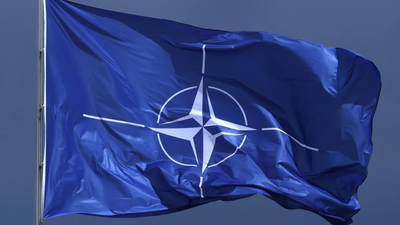ARTICLE AD BOX

Photo credit: Getty images
"I can vividly remember the last day," says Emerico Maria Laccetti, former colonel of the military division of Italian Red Cross.During the Kosovo War in 1999, he was stationed in Albania, just a few hundred meters from the border with Kosovo.
He was the commander of a field hospital for refugees from the province, which at the time belonged to Serbia."We stood on containers and watched the bombings. It was like a perverse New Year's Eve fireworks display. Even at a distance, you could feel the air pressure, the shock waves going through your body. But no, we were not told about the specific dangers of the weapons being used."In March 1999, Nato's Operation Allied Force intervened in the conflict between the Serbian state and the Albanian majority population in Kosovo, which had been simmering for years.
Over 78 days, the alliance flew missions with up to 1,000 aircraft against Serbian security forces. According to official figures, over 28,000 explosive devices were dropped, including controversial uranium ammunition, which is suspected of causing cancer.This ammunition contained a core of depleted uranium (DU), with high explosive power due to its high density, three times denser than lead. It is therefore used primarily against tanks and armored targets.
Its impact can produce fine uranium dust, which continues to emit radiation and can cause health problems, for example, if it is inhaled.
Nato rejects cancer accusations
In response to questions about the health risks posed by DU ammunition, Nato only gave a written statement. "We take health and environmental issues very seriously," it said. In 2001, a committee on DU concluded that the use of DU ammunition in Kosovo "did not cause any lasting health risk to the population," citing independent findings.Nato refers to UN reports from 2014. "This is scientific evidence; it was reliable, and we stand by it," the military alliance said in a statement.However, this contradicts the rulings of Italian courts on lawsuits filed by approximately 500 Kosovo War veterans who developed cancer after coming into contact with depleted uranium ammunition.Laccetti says he was aware that his field hospital in Morina, Albania, was located in a "hot zone," close to an active conflict, during the Nato bombings, something that would always entail risk."What we were never told, however, was that certain types of ammunition can pose long-term danger, even if you are not directly hit — for example, from an unexploded ordnance nearby or from substances used in ammunition production."
Triggering long-term illness
When Laccetti returned home in July 1999, he experienced breathing difficulties and went to the hospital to be examined. "The medical staff suddenly became very flustered," he recalled.Finally, a doctor showed him the image: "There was something in my lung measuring 24-by-12-by-14 centimeters (9.4-by-4.7-by-5.5 inches)." The then 36-year-old was diagnosed with a very aggressive malignant tumor.Laccetti was initially treated successfully, but in 2008, he fell ill with cancer again. The results of the tissue examination were alarming. "They found an extraordinary amount of perfectly round ceramic particles — as if I had been standing in a blast furnace." The conclusion was clear: "These particles had become lodged in my body over many years and could cause new damage through migration or inflammation."A sign under a tree shows a US flag in the village of Pllenaje in Kosovo.
Successful lawsuits in Italy
Laccetti learned of other soldiers of the same age who had been stationed nearby and received similar diagnoses. He contacted lawyer Angelo Tartaglia, who represented those affected.Approximately 500 military personnel successfully sued the state of Italy.
Among them was Laccetti, whom a court in Rome certified in 2009 as a victim because he had fulfilled his military duties. The court awarded him compensation. After the Kosovo War, a commission of the Italian Ministry of Defense investigated a possible link between DU exposure and cancer. It found a statistically significant increase in the incidence of non-Hodgkin lymphoma, a group of blood cancers, among affected soldiers.
However, other studies, such as a WHO report from the same year, found no clear evidence of a direct link between DU and individual cases of disease.
Difficult to prove a cancer link
For Wim Zwijnenburg, a member of the International Coalition to Ban Uranium Weapons (ICBUW), the case is clear-cut."The judge recognized that the Italian state had a duty of care, which is why compensation was awarded," explained Zwijnenburg, who has been investigating the use and consequences of DU for over 16 years."My conclusion is it is extremely difficult to make a definitive statement," he admits, because depleted uranium only has an effect when it enters the body, usually in the form of fine dust particles that are inhaled. "But the exact amount that people actually absorb has never been properly measured. There are very few reliable long-term studies." The causes of cancer are often difficult to pinpoint. Unhealthy lifestyles, environmental influences, genetic predisposition and many other factors contribute to the number of cases."It's difficult to prove," says Zwijnenburg. "Have those affected ever touched a DU grenade or been near a contaminated tank? Uranium can take a year to penetrate the skin. Doctors cannot make any claims if it is not completely clear. People are looking for a clear cause, but the reality is far more complex."
Did Nato do enough to clean up Kosovo?
In 2002, the United Nations passed a resolution obliging countries to inform affected states after the use of uranium ammunition and to assist in the cleanup of contaminated areas.
It is unclear to what extent Nato fulfilled this responsibility in Kosovo, the Nato peacekeeping force KFOR, which has been stationed there since the end of the fighting to secure peace, does not provide any information.Visits to the sites show that the population in many regions of Kosovo is unaware of the potential risks, and decontamination measures have not been carried out, except at one site in the west of the country, in the village of Lugbunari near Gjakova."Nato could be criticized for using these weapons," said expert Wim Zwijnenburg, "but even more so for not carrying out clean-up operations after the war. There are clear protection protocols for soldiers — but for civilians? Nothing. It is unacceptable to use toxic ammunition and then simply turn away."Officially, the material that DU ammunition is made of is classified as low- to medium-level radioactive waste.
But, Zwijnenburg said, "in humid climates such as the Balkans, shells can corrode and disintegrate, leaving behind dangerous residues." The risk doesn't fade with time either, as the half-life of uranium is almost infinite. For Zwiijnenburg, this is evidence of the states' double standards."If such a grenade were to be found in a Dutch park, the area would be cordoned off. Special forces in protective suits would place the grenade in a lead container and store it safely."
So when it comes to their own population, risks are taken extremely seriously — but elsewhere, they are not.Laccetti is disappointed that his case and those of many other veterans have not brought about any fundamental changes. "Depleted uranium ammunition is still legal. We have tried in every conceivable way to ban it, like cluster munitions or anti-personnel mines," he said. "We have failed."

 1 hour ago
5
1 hour ago
5









 English (US) ·
English (US) ·